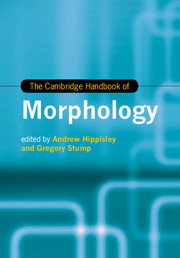
-
Select format
-
- Publisher:
- Cambridge University Press
- Publication date:
- January 2017
- November 2016
- ISBN:
- 9781139814720
- 9781107038271
- Dimensions:
- (247 x 174 mm)
- Weight & Pages:
- 1.86kg, 878 Pages
- Dimensions:
- Weight & Pages:
You may already have access via personal or institutional login- Collection:
- Cambridge Handbooks of Linguistics
Book description
The Cambridge Handbook of Morphology describes the diversity of morphological phenomena in the world's languages, surveying the methodologies by which these phenomena are investigated and the theoretical interpretations that have been proposed to explain them. The Handbook provides morphologists with a comprehensive account of the interlocking issues and hypotheses that drive research in morphology; for linguists generally, it presents current thought on the interface of morphology with other grammatical components and on the significance of morphology for understanding language change and the psychology of language; for students of linguistics, it is a guide to the present-day landscape of morphological science and to the advances that have brought it to its current state; and for readers in other fields (psychology, philosophy, computer science, and others), it reveals just how much we know about systematic relations of form to content in a language's words - and how much we have yet to learn.
Reviews
'Wide-ranging and comprehensive, this volume is a welcome addition to the reference volumes currently available in the field of linguistic morphology. Covering everything from general theoretical issues, contemporary frameworks, and interfaces with phonology and syntax to computational, experimental, and psycholinguistic approaches, it will be a valuable resource to linguists and scholars in related fields.'
Rochelle Lieber - University of New Hampshire
'A fine wide-ranging overview, carefully planned and well executed. It is packed with analysis and insight, demonstrating the substantial progress that morphologists have made over recent years. This timely book will be invaluable not only to morphologists, but also to syntacticians and phonologists.'
Greville G. Corbett - Surrey Morphology Group
'The Cambridge Handbook of Morphology provides a rich and up-to-date compendium of the problems that morphology poses for descriptive and theoretical linguistics, and of the ways in which linguists have tried to approach those problems; the volume will be invaluable to morphologists as a definition of the state of the art, and to other linguists interested in entering or keeping up with this field.'
Bernard Comrie - University of California, Santa Barbara
Contents
Metrics
Altmetric attention score
Full text views
Full text views help Loading metrics...
Loading metrics...
* Views captured on Cambridge Core between #date#. This data will be updated every 24 hours.
Usage data cannot currently be displayed.
Accessibility standard: Unknown
Why this information is here
This section outlines the accessibility features of this content - including support for screen readers, full keyboard navigation and high-contrast display options. This may not be relevant for you.
Accessibility Information
Accessibility compliance for the PDF of this book is currently unknown and may be updated in the future.


